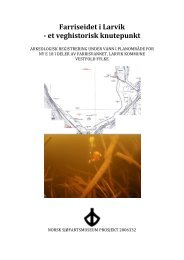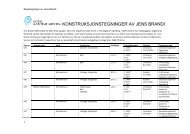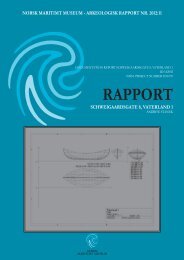Last ned 2009230_Rapport_Sørenga9_liten.pdf - Norsk Maritimt ...
Last ned 2009230_Rapport_Sørenga9_liten.pdf - Norsk Maritimt ...
Last ned 2009230_Rapport_Sørenga9_liten.pdf - Norsk Maritimt ...
You also want an ePaper? Increase the reach of your titles
YUMPU automatically turns print PDFs into web optimized ePapers that Google loves.
The Anglo-Saxon Laboratory<br />
Catalogue for archive of caulking materials from Sørenga 8, Sørenga 9 and Båtflak<br />
Penelope Walton Rogers, 27 February 2012<br />
Sørenga 8<br />
X030: from strake part x021<br />
A folded pad of textile fragments, measuring approximately 150 x 100 x 45 mm. There are two<br />
different textiles present.<br />
(a) The largest fragment, 250 x 210 mm, has been repeatedly folded and re-folded. It is a 2/1<br />
twill with the wale running Z-wise, warp/6-7/Z/1.2 x weft/5/S/2.0 per cm. It has both cut and<br />
torn edges and the main outer fold has received extensive wear. There is at least one weaving<br />
gore present.<br />
Fibre WOOL fibres with moderate-dense pigmentation throughout: dark brown originally.<br />
(b) Similar to (a) but slightly finer, 7-8/Z/1.2 x 6/S/1.2-2.0 per cm.<br />
Fibre WOOL fibres approximately 30% moderately pigmented fibres in the Z-spun system and<br />
20% the same in S-spun system: brown-and-white ‘oatmeal’ originally.<br />
X031: from boat part x001, keel (NIKU F618)<br />
A fragment of textile, 110 x 60 mm, woven in 2/1 twill with wale running Z-wise, 8-9/Z/1.0 x<br />
7/S/1.2 per cm. Slightly matted on S-face.<br />
Fibre White WOOL with an occasional pigmented fibre (maximum of 20% pigmented fibres in<br />
one Z-spun yarn).<br />
X034: caulking from boat part x004 (NIKU P#99)<br />
A caulking cord, approximately 0.8 m (800mm) long x 25 x 10mm. It has been plied S2Z, angle of<br />
helix 30°.<br />
Fibre Animal fibres still in their original staples, 30 mm long with roots at one end and intact tips<br />
at the other. They are 25-82 microns diameter, with one at 104 microns and the mean, based on<br />
measurement of 20 fibres, is 55 microns. Pigmentation mostly light or absent, but some of the<br />
coarser fibres (15%) have moderate-dense pigmentation. 60% of fibres have medullas, some<br />
wide and continuous, others narrow and fragmented. The scale pattern is irregular waved<br />
mosaic with smooth margins, waved in places. Cross-sections are robust oval, or rarely circular.<br />
Young CATTLE.<br />
X046: from the outside land edge of plank x009 del B.<br />
A caulking cord folded into an area 340 x 90 mm: unfolded it is approximately 1 metre long x 24<br />
x 9 mm. It has been plied S2Z, angle of helix 30-35°.<br />
Fibre<br />
(a) Animal fibres, still with some intact staples present, 55 mm long, roots present, but no tips<br />
detected. 19-82 microns diameter (mean 50 microns based on 25 fibres). Pigmentation mostly<br />
light or absent. 48% of fibres have medullas, some wide, mostly narrow and continuous. The<br />
scale pattern is irregular waved mosaic with smooth margins. Cross-sections are robust, circular,<br />
oval and elliptical. Young CATTLE. Confirmed by Microtex<br />
(b) Similar to above, but with more fine fibres, 15-25 microns diameter. Cross-sections all ovalelliptical.<br />
1








